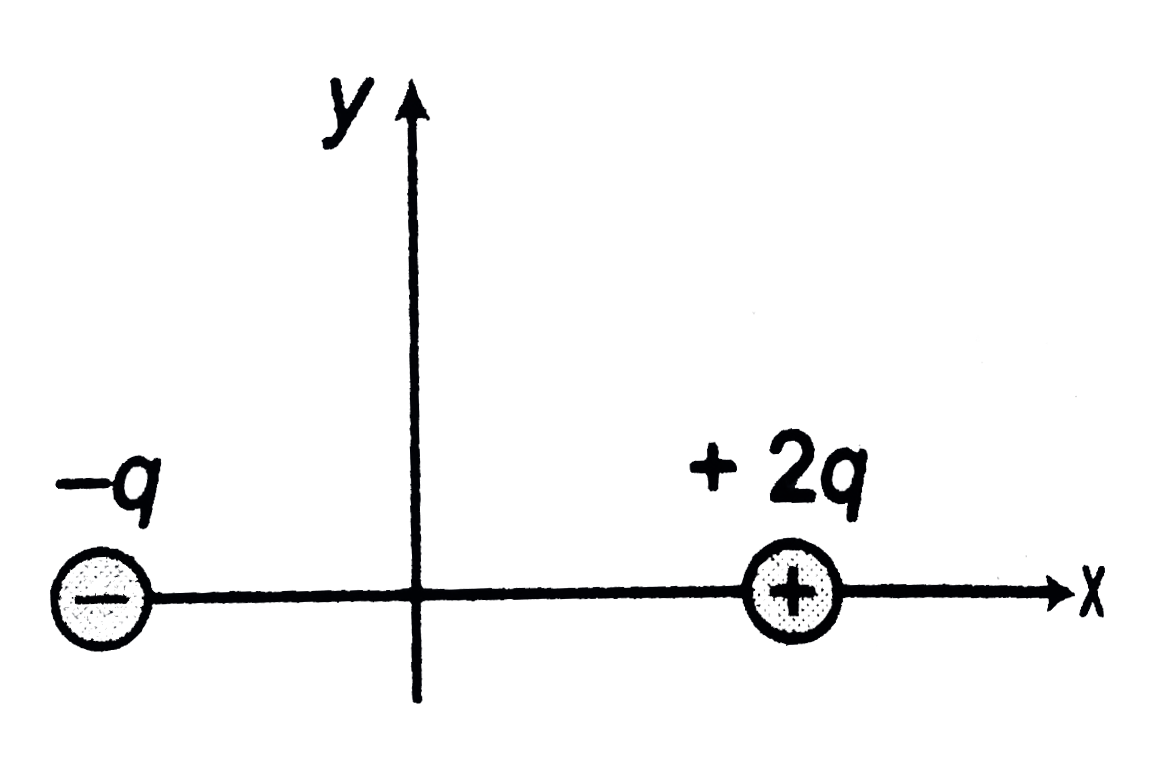Two identical charge of value Q each are placed at (-a,0) and (a , 0) . The end coordinates of the point where the net electric field is zero and maximum are respectively-
(0,0), (0,0)
(0,a√2),(0,0)
(0,0),(0,a√2)
(a√2,0),(0,a√2)
The correct Answer is:C
To solve the problem, we need to find the coordinates where the net electric field due to two identical charges Q placed at points (−a,0) and (a,0) is zero and where it is maximum.
1. Understanding the Setup:
We have two identical charges Q located at (−a,0) and (a,0). We need to analyze the electric field created by these charges at various points along the y-axis (vertical line).
2. Electric Field Due to a Point Charge:
The electric field E due to a point charge Q at a distance r is given by:
E=kQr2
where k is Coulomb's constant.
3. Distance Calculation:
For a point on the y-axis at (0,y), the distance from each charge to this point is:
r=√a2+y2
4. Electric Field Components:
The electric field at point (0,y) due to the charge at (−a,0) will point away from the charge, and similarly for the charge at (a,0). The vertical components of the electric fields from both charges will add up, while the horizontal components will cancel each other out.
5. Net Electric Field Calculation:
The net electric field Enet in the y-direction is given by:
Enet=2Ecos(θ)
where cos(θ)=y√a2+y2. Thus,
Enet=2⋅kQa2+y2⋅y√a2+y2=2kQy(a2+y2)3/2
6. Finding Points Where Electric Field is Zero:
To find where the electric field is zero, set Enet=0:
2kQy(a2+y2)3/2=0
This implies y=0. Therefore, the net electric field is zero at the origin (0,0).
7. Finding Maximum Electric Field:
To find where the electric field is maximum, we differentiate Enet with respect to y and set the derivative to zero:
dEnetdy=0
After differentiating and simplifying, we find that y2=a2/3. Thus,
y=±a√3
The coordinates where the electric field is maximum are (0,a√3) and (0,−a√3).
Final Answer:
- The coordinates where the net electric field is zero: (0,0)
- The coordinates where the net electric field is maximum: (0,a√3) and (0,−a√3)
We have two identical charges Q located at (−a,0) and (a,0). We need to analyze the electric field created by these charges at various points along the y-axis (vertical line).
The electric field E due to a point charge Q at a distance r is given by:
E=kQr2
where k is Coulomb's constant.
For a point on the y-axis at (0,y), the distance from each charge to this point is:
r=√a2+y2
The electric field at point (0,y) due to the charge at (−a,0) will point away from the charge, and similarly for the charge at (a,0). The vertical components of the electric fields from both charges will add up, while the horizontal components will cancel each other out.
The net electric field Enet in the y-direction is given by:
Enet=2Ecos(θ)
where cos(θ)=y√a2+y2. Thus,
Enet=2⋅kQa2+y2⋅y√a2+y2=2kQy(a2+y2)3/2
To find where the electric field is zero, set Enet=0:
2kQy(a2+y2)3/2=0
This implies y=0. Therefore, the net electric field is zero at the origin (0,0).
To find where the electric field is maximum, we differentiate Enet with respect to y and set the derivative to zero:
dEnetdy=0
After differentiating and simplifying, we find that y2=a2/3. Thus,
y=±a√3
The coordinates where the electric field is maximum are (0,a√3) and (0,−a√3).
- The coordinates where the net electric field is zero: (0,0)
- The coordinates where the net electric field is maximum: (0,a√3) and (0,−a√3)
Topper's Solved these Questions
Similar Questions
Knowledge Check
- Question 1 - Select One
Two charge 9e and 3e are placed at a distance r. The distance of the point where the electric field intensity will be zero is :
A(r1+√3) from 9e chargeB(r1+√1/3) from 9e chargeC(r1−√3) from 3e chargeD(r1+√1/3) from 3e charge - Question 2 - Select One
Two charges e and 3e are placed at a distance r. The distance of the point where the electric field intensity will be zero is
Ar(1+√3) from 3e chargeBr(1+√3) from e chargeCr(1−√3) from 3e chargeDr1+√13 from e charge - Question 3 - Select One
Charge 2qand−q are placed at (a,0)and(−a,0) as shown in the figure. The coordinates of the point at which electric field intensity is zero will be (x,0) where
 A−a<x<aBx<−aCx>−aD0<x<a
A−a<x<aBx<−aCx>−aD0<x<a
Two charges q1andq2 are placed at (0,0,d) and (0,0,-d) respectively. Find locus of points where the potential is zero.
View SolutionTwo charges q1andq2 are placed at (0,0d)and(0,0−d) respectively. Find locus of points where the potential is zero.
View SolutionTwo charge _q and -3q are placed at a distance of 1 m apart.Find out the points on the line joing two charges, where electric potential is zero.
View SolutionTwo point charges+q nd -q are held fixed at (−a,0) and (a,0) respectively of a x-y coordinate system then
View SolutionTwo point charges (Q each are placed at (0,y) and (0-y) A point charge q of the sme polarity can move along the x-axis. Then
View Solution


